
Additional Information
Book Details
Abstract
Graphene is an emerging material for generating polymer nanocomposites. Its heat conducting properties are greater than any other material, yet so dense not even helium can pass through its honeycomb lattice. The inclusion of small amounts of graphene to polymer matrices has the possibility of significantly improving their electrical, barrier and mechanical properties. Since the Nobel prize for Physics was awarded in 2010 for the isolation of graphene there has been an explosion in graphene research and the discovery of new applications. This book discusses the current state-of-the-art in graphene nanocomposites with expertise drawn from across the globe. Insights into the functionalisation of graphene are presented, in the context of various polymer systems, along with appropriate methodologies to be adopted. Grasping this view from several active researchers in the field gives the editor the opportunity to look where future trends are heading. This is an important handbook for anyone wishing to get a comprehensive view of the field and bring established methodologies into their laboratory and will benefit post-graduate students and established researchers alike.
Vikas Mittal received his degree in Chemical Engineering from the Punjab Technical University in India. He then went on to obtain his Master of Technology in Polymer Science and Engineering from the Indian Institute of Technology in Delhi, India. His doctorate on surface chemistry and polymer nanocomposites is from the Swiss Federal Institute of Technology in Zurich. He then worked at the Active and Intelligent Coatings section of the Sun Chemical Group, Europe in London on the development of water and solvent based coatings for food packaging applications. He is currently working as a Polymer Engineer at BASF Polymer Research in Germany where he is responsible for the physical analysis of organic and inorganic colloids.
